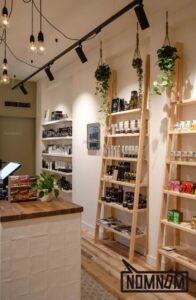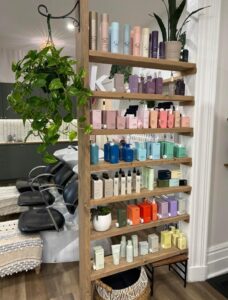Creating a visually appealing and memorable retail space within a small area can be challenging, but with thoughtful design and strategic planning, you can make your store look both spacious and captivating.
Here’s a comprehensive breakdown of techniques to make your small retail space eye-catching and functional.
- Maximize Vertical Space: Elevate Your Design
Small retail spaces often lack width but can benefit greatly from height. Utilizing vertical space not only makes the area feel larger but also draws the customer’s eyes upward, creating a sense of openness.
- a) Floor-to-Ceiling Shelves:
- Opt for tall, narrow shelving units to utilize the vertical dimension without taking up too much floor space.
- Use ladder-style racks or modular shelving to maintain a stylish, dynamic look.
- Display your most popular or visually appealing items at eye level while reserving the highest shelves for storage or decorative pieces.
- Pro Tip: Combine open shelves with enclosed cabinetry to reduce visual clutter while still offering ample storage.
- b) Hanging Installations:
- Incorporate hanging planters, chandeliers, or pendant lights to add texture and depth.
- Suspend products like scarves, hats, or lightweight accessories from hanging racks.
- Use ceiling-mounted grid panels for dynamic displays that can be rearranged seasonally.
- Visual Trick: Use transparent or metallic chains to give a floating illusion, enhancing the feeling of space.
- c) Vertical Signage and Banners:
- Install vertical flags, banners, or roll-up displays at the entrance to attract passersby.
- Use fabric banners with your brand logo or key messages for a soft, modern look.
- Integrate floor-to-ceiling graphic walls that change seasonally, keeping the space fresh.
- Create a Bold Focal Point: Make a Statement

Focal points catch attention and create a memorable impression. Use a singular, impactful element that embodies your brand’s aesthetic.
- a) Statement Wall:
- Choose a wall to feature a bold design – think murals, branded wallpaper, or a contrasting paint colour.
- Incorporate texture through wood panelling, brick, or patterned tiles.
- Display your brand’s story or highlight your flagship products with illuminated signage.
- Design Tip: Consider a photo-worthy wall where customers can take selfies and tag your store on social media.
- b) Interactive Displays:
- Use a touchscreen to let customers browse catalogues, view tutorials, or learn more about your products.
- Set up a selfie station with branded props or interactive mirrors that light up when approached.
- Incorporate QR codes that link to online shopping, allowing customers to explore more options without taking up space.
- c) Illuminated Logo or Sign:
- Use backlit signage to make your logo glow, drawing attention even from a distance.
- Install a custom neon sign that communicates your brand’s personality and sets the tone for the space.
- Practical Tip: LED lightbox displays are energy-efficient and can be easily updated for promotions.
- Use Mirrors to Expand the Space
Mirrors create the illusion of space and reflect light, making the area feel larger and more welcoming.
- a) Mirror Placement Strategies:
- Position large mirrors opposite windows to reflect natural light and brighten the space.
- Use mirrored wall panels behind display units to add depth and showcase products from multiple angles.
- Install a series of smaller mirrors in geometric patterns to add a modern touch while maintaining functionality.
- Style Tip: Opt for decorative mirror frames that complement your brand’s aesthetic.
- b) Reflective Display Stands:
- Use mirrored bases for product stands to give the illusion of floating items.
- Acrylic or glass shelving with reflective edges can add a sense of lightness to your displays.
- Position mirrored plinths in the centre of the room to create a focal point without overwhelming the space.
- Optimize Product Placement for Visual Flow
Proper product placement not only makes the space functional but also guides the customer journey effectively.
- a) Feature Zones:
- Create designated areas for seasonal items, new arrivals, or bestsellers.
- Use visual markers like rugs or lighting changes to subtly differentiate these zones.
- Position “hero products” at the entrance or near the checkout to maximize visibility.
- Psychology Tip: Place impulse buys at the counter where customers wait to check out.
- b) Rotating Displays:
- Change product arrangements frequently to keep regular customers engaged.
- Incorporate movable displays like wheeled carts or stackable boxes to easily transform the layout.
- Use modular racks that can be reconfigured for different product categories.

- Creative Lighting for Ambiance and Highlighting
Lighting is crucial for setting the mood and highlighting products effectively.
- a) Layered Lighting Approach:
- Ambient Lighting: Use overhead fixtures for general illumination, like track lights or chandeliers.
- Task Lighting: Focused lights above work areas or checkout counters.
- Accent Lighting: Spotlights on product displays to draw attention to key items.
- Pro Tip: Use dimmers to adjust lighting intensity based on time of day or mood.
- b) Statement Fixtures:
- Incorporate artistic chandeliers or pendant lights that double as décor elements.
- Use Edison bulbs or filament lights for a vintage touch.
- LED strips under shelving or behind product displays create a modern, high-end feel.
- Engaging the Senses for a Memorable Experience
Making a space eye-catching goes beyond visuals; engaging other senses can enhance the overall customer experience.
- a) Scent Marketing:
- Choose a signature scent that aligns with your brand – floral for a boutique, earthy for eco-friendly products.
- Use discreet scent diffusers to maintain consistency without overwhelming.
- b) Background Music:
- Choose soundtracks that complement your brand – upbeat pop for trendy apparel, calming melodies for wellness products.
- Use strategically placed speakers to ensure even sound distribution.
- c) Texture and Tactile Appeal:
- Offer samples or tactile displays, especially for products with unique textures.
- Include natural materials like wood or woven baskets to add warmth and authenticity.
- Branding and Signage: Cohesive and Professional
Consistent branding reinforces identity and makes the space feel thoughtfully curated.
- a) Cohesive Colour Palette:
- Use your brand colours throughout, from wall accents to signage and even staff uniforms.
- Integrate colour in subtle ways, such as shelf edging or product labels.
- b) Personalized Touches:
- Handwritten signs or chalkboards create an approachable and authentic feel.
- Display your brand story on a feature wall to foster a personal connection.
- Keep the Space Clutter-Free
A small space can easily become chaotic. Use organization systems that are both functional and aesthetic.
- a) Hidden Storage:
- Opt for cabinetry with sliding doors or pull-out drawers to conceal excess stock.
- Multi-functional furniture like storage ottomans or benches can provide seating while hiding supplies.
- b) Strategic Grouping:
- Group items by colour, size, or use to make browsing intuitive and satisfying.
- Avoid overcrowding – less is more when space is limited.
Finally, be creative and have fun designing a retail area with your team, I personally find Pinterest great for being inspired with designs and how to ideas!


